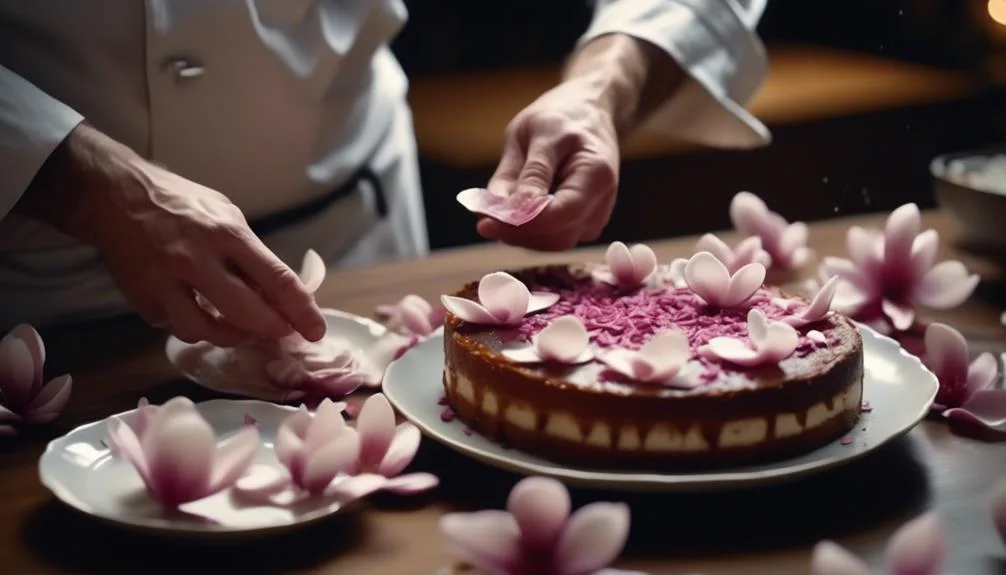Curious about using magnolia flowers in your cooking? These delicate blooms can add an elegant floral touch to your dishes, whether you're a seasoned chef or a home cook.
From infusions to garnishes, there are endless possibilities to explore. Enhance your culinary repertoire with a dash of floral flair and discover the potential of these beautiful blooms in the kitchen.
Selecting Fresh Magnolia Flowers
When selecting fresh magnolia flowers, look for blooms that are fully open and free from blemishes or discoloration. Magnolia petals should be plump, vibrant, and fragrant. Avoid any flowers that appear wilted or have brown spots.
Choose flowers from trees that haven't been treated with pesticides or other chemicals. It's important to use magnolia petals that are safe for consumption, especially if you plan to use them in culinary creations. When making an edible flower selection, ensure that the petals are clean and haven't been exposed to pollutants.
Freshly picked magnolia flowers are ideal for adding a subtle citrusy flavor to dishes or for creating visually stunning garnishes. Selecting the finest blooms will enhance the overall quality and taste of your culinary masterpieces.
Preparing Magnolia Flowers for Cooking
As you move from selecting fresh magnolia flowers to preparing them for cooking, ensure that the blooms you have chosen meet all the criteria for safety and freshness, as this will greatly impact the flavor and visual appeal of your culinary creations. To prepare magnolia flowers for cooking, start by gently cleaning the petals to remove any dirt or insects. Then, soak the petals in a bowl of cold water for about 15 minutes to ensure they are free of impurities. After soaking, gently pat the petals dry with a paper towel. Here's a helpful table to guide you through the process:
| Step | Instructions |
|---|---|
| Cleaning | Gently remove any dirt or insects from the petals. |
| Soaking petals | Place the petals in a bowl of cold water for 15 minutes. |
Incorporating Magnolia Flowers in Recipes
Explore the delightful ways in which magnolia flowers can elevate your culinary creations with their unique flavor and visual appeal. Incorporating magnolia flowers in recipes opens up a world of creative possibilities. You can infuse flavors and create visually stunning edible garnishes.
Here are some exciting ways to incorporate magnolia flowers into your recipes:
- Infuse magnolia flowers into syrups or honey to add a delicate floral essence to cocktails and desserts.
- Use magnolia petals as a beautiful and edible garnish for salads, cakes, and pastries.
- Create floral-infused ice cubes by freezing magnolia flowers in water for a refreshing and visually appealing addition to beverages.
- Incorporate magnolia petals into homemade jams or jellies for a unique twist on traditional spreads.
- Experiment with incorporating magnolia flowers into savory dishes such as stir-fries or rice pilaf for a surprising burst of floral flavor.
Enhancing Dishes With Magnolia Flowers
To enhance your culinary creations, consider adding magnolia flowers to infuse a subtle floral essence or to create visually stunning edible garnishes. When infusing flavors, gently heat a neutral oil and add fresh magnolia petals, allowing the oil to cool and infuse for a delicate, fragrant addition to dressings or marinades.
For a creative presentation, crystallize magnolia flowers by brushing them with egg white, sprinkling with sugar, and allowing them to dry for an exquisite and edible decoration. Alternatively, use the whole flowers to adorn desserts, salads, or cocktails, adding a pop of color and a touch of elegance.
The versatility of magnolia flowers in enhancing dishes goes beyond taste, elevating the visual appeal and sensory experience of your culinary creations.
Storing and Preserving Magnolia Flowers
Preserving the delicate fragrance and visual appeal of magnolia flowers is essential for maximizing their culinary potential, ensuring that they maintain their freshness and beauty for use in a variety of dishes.
To preserve magnolia flowers effectively, consider the following techniques:
- Drying: Air-drying or using a food dehydrator can help preserve magnolia flowers for long term storage.
- Freezing: Store magnolia flowers in an airtight container in the freezer to maintain their freshness.
- Infusing: Create magnolia-infused oils or syrups to capture and preserve their unique flavor.
- Freshness Indicators: Check for firm, vibrant petals and a strong, sweet fragrance to ensure the flowers are at their peak.
- Seasonal Availability: Harvest magnolia flowers during their peak season for the best flavor and quality.
Conclusion
As you embark on your culinary journey with magnolia flowers, remember to savor their delicate flavor and stunning appearance in your dishes.
Whether it's salads, desserts, or infused oils and syrups, these blooms will add a unique touch to your cooking.
Properly storing and preserving them ensures their freshness for future culinary adventures.
Happy cooking, and may your creations continue to bloom with beauty and flavor.

My interest in trees started when I first saw the giant sequoias in Yosemite.
I was a teenager then, and I remember thinking, “I need to learn more about this.”
That moment stuck with me.
A few years later, I went on to study forestry at Michigan Tech.
Since graduating, I’ve worked in a mix of hands-on tree care and community education.
I’ve spent over ten years helping people understand how to plant, maintain, and protect the trees in their neighborhoods.
I don’t see trees as just part of the landscape.
They are living things that make a real difference in our daily lives.
